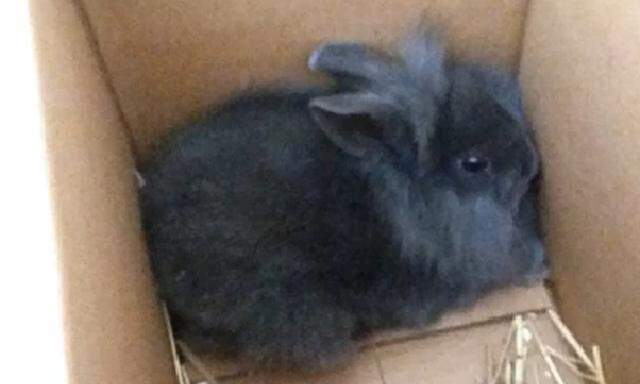Der Sender wollte mit der Aktion auf die grausamen Methoden der Agrarwirtschaft aufmerksam machen. Im Studio kam es zu einem Tumult.
Die Tötung eines Kaninchens während einer Radio-Sendung hat in Dänemark für Aufsehen gesorgt. Der Sender Radio24syv rechtfertigte die Aktion am Dienstag im Kurznachrichtendienst Twitter: "Wir haben es nicht um der Unterhaltung willen getan." Tausende Tiere würden täglich getötet, damit Menschen sie essen könnten. Es gehe darum, auf die grausamen Methoden der Agrarwirtschaft aufmerksam zu machen.
Moderator Asger Juhl, hatte das junge Kaninchen namens Allan am Montag während der Sendung mit mehreren Schlägen mit einer Luftpumpe auf den Kopf getötet. Damit habe die "Heuchelei" der Dänen beim Tierschutz entlarvt werden sollen, twitterte der Sender.
Im Studio kam es zu einem Tumult, als Reality-Showstar und Tierrechteaktivistin Linse Kessler versuchte, das Kaninchen zu retten und Juhl durch das Studio jagte, bevor sie es verlassen musste. Auf ihrer Facebook-Seite schrieb Kessler, sie hätte das Tier fassen und Juhl entwinden können, habe aber gefürchtet, dass es dadurch noch größeren Schaden erlitten hätte.
Später gehäutet, zerlegt, gekocht
Juhl bestritt im Fernsehen, dass das Kaninchen Qualen erlitten habe: Er habe es so hart geschlagen, dass es zu einem Genickbruch gekommen sei. Die Technik habe ihm ein erfahrener Tierpfleger im Zoo von Aalborg gezeigt, sagte er TV2. Das tote Tier habe er zu Hause zusammen mit seinen sechs und acht Jahre alten Kindern gehäutet, zerlegt und zu einem Gericht zubereitet, das sie gemeinsam mit Ko-Moderator Kristoffer Eriksen abends gegessen hätten.
Im Internet waren die Ansichten über die Aktion geteilt: "Provozieren und für sich selbst werben", twitterte ein Nutzer. Ein anderer schrieb: "Wie wäre es, wenn sich die Leute genauso über ertrunkene Flüchtlinge aufregen würden." Zuletzt hatte ein Zoo in Kopenhagen im vergangenen Jahr für Empörung unter Tierfreunden gesorgt, als eine gesunde Giraffe namens Marius getötet und zur Verfütterung an andere Zootiere vor den Augen von Kindern zerlegt wurde.
Statement des Radiosenders auf Facebook
"Every day in the nation of Denmark, thousands and thousands of animals are put down to fill the meat counters in our super markets. Danish agriculture is one of the most industrialized in the world. But we do not seem to focus much on animal welfare.
Denmark is one of the top countries in the world, when it comes to consumption of meat products and consumers do not hesitate to buy cheap meat in stores without asking questions about the life or death of the animal. Meat from chickens, pigs, cows and sheep, that have not lead a dignified or pleasant life.
Danish consumers allow chicken farms to keep 13 chickens per square meter. And they accept lengthy and painful transport of animals to the slaughterhouse.
In Danish pig farms, 25.000 piglets die every day, because agriculture has bred pigs that give birth to more piglets than the sow can feed. This is wasted life.
These conditions provoke very few reactions from the consumers. Animal welfare does not seem to apply to animals in the food industry.
This is an interesting issue, which the Danish public service radio broadcaster, Radio24syv, wishes to highlight.
Therefore, on May 25th, we chose to put down a rabbit during a live radio broadcast. An animal which is both a pet and a farm animal.
We anticipated strong reactions. To take the life of an animal brings about strong emotional response in vast segments of the public. It was important to us that the rabbit would not suffer unnecessarily, and was put down accordingly to careful instructions by a professional animal caretaker from a Danish Zoo.
We knew that we would be accused of provocation. And yes, we indeed wanted to provoke the public and to stir a debate about the hypocrisy when it comes to perceptions of cruelty towards animals.
But it is not an empty provocation; the presenters of the program ate the animal after killing it.
Consumers generally do not kill animals themselves, but we buy and eat animals, that have lead sad lives. We just don’t see it, and don’t consider the animals ‘cute’ as the rabbit.
These animals have often endured horrific suffering on their way to our dinner tables. These animals are killed according to the same controlled conditions as our studio rabbit, and without it invoking any strong reactions or calls for boycott. We at least believe that the studio rabbit have had a comfortable existence.
We wanted to expose the vast hypocrisy surrounding our relationship with animals. So far we have succeeded.
We wanted and want to have a debate about animal welfare - for ALL animals."
(APA/AFP/Red.)
